Touring Spain by Motorhome
Want to tour Spain by motorhome or campervan? This hands-on guide includes all the practical information you’ll need to know before you go!
Spain in a Nutshell
Key Facts for Touring Spain by Motorhome
![]() If you’re pressed for time, here are the essential facts to know when planning your motorhome tour of Spain. We dive into more detail on each of these later in this guide.
If you’re pressed for time, here are the essential facts to know when planning your motorhome tour of Spain. We dive into more detail on each of these later in this guide.
- Weather – Spain is an all-season destination, with the best winter weather being in the far south in Andalusia. Temperatures in summer can get uncomfortably hot, and many mountainous areas can see snow in winter.
- Currency – Spain uses the Euro (€). £1 is worth around €1.2.
- Insurance – most motorhome insurance policies will cover Spain – check your policy.
- Language – Spain has a number of official languages. Castilian is spoken across the whole country, but you’ll also come across Basque, Catalan and others on a country-wide tour.
- Place to Stay – Camping’s big in Spain, although many sites away from the Med close over winter. You’ll also find motorhome aires and, at quieter times and in less tourist-oriented areas, free (wild) camping is easily possible.
- Mobile Phone and Internet – you can usually use your UK phone and Internet allowance in Spain, check with your provider. We use Three and Vodafone pay-as-you-go SIM cards for Internet (more information here), and 1p Mobile SIM cards for phone calls.
- Getting there from the UK – there are ferry routes direct from the UK to northern Spain, or you can opt to take a ferry/the Chunnel to France and drive down to the Pyrenees.
- Renting a Van – if you don’t have the time to drive your own motorhome, there are several companies renting vans in Spain. Expect prices of roughly £700 to £1000 a week for a two berth C Class coachbuilt.
- Customs – you can cross borders between EU countries with large amounts of alcohol and tobacco, as long as it’s for personal use. There are customs posts at the land border with France but they are normally unmanned and you can drive across without stopping or showing passports.
- Pet Dogs – you can take your pet dogs and cats (or ferrets) to Spain and return to the UK with them without quarantine. You’ll need a valid Pet Passport for this (talk to your vet), and will need to visit a vet for a worming treatment on your way back to the UK.
- Roads – generally very well-maintained and with little traffic compared with the UK. Spain drives on the right.
- Low Emission Zones – Spain has introduced LEZs in Madrid and Barcelona, and has restrictions in other cities.
- Headlights – some countries mandate the use of dipped headlights even during bright daylight. Spain doesn’t have this law.
- Compulsory Equipment – download the AA’s latest requirements PDF to see what you need to carry. Note that if you have anything extending the back of your van, like a bike rack, you legally need a warning sign attached to it, like this one.
- Tyres – check the AA’s page for the latest details. If you plan to drive mountainous areas in winter, you may need M+S or full winter tyres and snow chains.
- LPG (Gas) – Autogas (GPL) refill stations are available fairly widely across Spain, especially at Repsol garages. Spain uses the Euroconnector LPG adapter. If you don’t have a self-refillable system, note that you can’t usually get Calor Gas bottles in Spain.
- Tolls – Spain has a good network of free motorways. Some sections of motorway are toll though, and you can pay tolls in cash or card.
Great Places to Motorhome to in Spain
On our first motorhome trip to Spain we were amazed to find the beautiful Picos de Europa mountains in the north, having just come from the bay and pintxos bars in the proud sea-side city of San Sebastian (Donastia in Basque). Since then we’ve been wowed by the architectural wonders of Seville, Barcelona, Córdoba and Grenada, been welcomed into the white hill towns of Andalucia, put our feet up on the beaches of the costas and squeezed down the mountain roads of the Pyrenees. Still, we’ve barely scratched the surface of sunny Espagne.
Here are just a few of the places we’ve visited. Click on the links below to get the full blog post, with the GPS co-ordinates of where we stayed overnight.
- San Sebastian – Donastia (blog post here)
- Salamanca (blog post here)
- Benarrabá, a hill town in Andalusia (blog post here)
- Sierra Nevada (blog post here)
- Ronda (blog post here)
- Granada (blog post here)
- Seville (blog post here)
- Mojácar (blog post here)
- Benidorm (blog post here)
- Morella (blog post here)
- Barcelona (blog post here)
- Picos de Europa Mountains (blog post here)
A Quick Look at Spain – Some Short Videos
The low-cost motorhome aire in San Sebastian (Donastia)
The Andalusian Pueblo Blanco of Casares
Driving a motorhome to the Lakes of Covadonga, Picos de Europa
Looking out from the castle in Morella
Walking the Caminito del Rey
Driving a motorhome down the Foz de Binies Gorge, Pyrenees
How Much Does it Cost to Tour Spain?
Like many countries in Europe, once you’re there, Spain can be toured in a motorhome without breaking the bank. While there are toll motorways, there’s also a good network of fast free roads. Diesel and petrol prices are relatively low (rough prices here). Free (wild) camping is possible outside of heavily visited areas in summer (have a look at ourbumble.com’s wild camping map). There’s a network of low cost motorhome aires, and over 200 campsites are listed in the out-of-season discounted camping ACSI CampingCard scheme (park4night.com lists over 10,000 places to stay in Spain). Supermarket prices are relatively low, easpecially for wine! By eating the incredible value menú del dia at lunchtime, you can also eat out for as little as €10 a head for 3 courses, often including wine.
One of the major costs for a tour of Spain is getting there and back from the UK. The obvious choices are to either take a ferry across the Bay of Biscay, or drive across France. As a general rule, it’ll be cheaper to drive across France, especially if you have the time to avoid toll roads, and you use aires to overnight (avoid aires directly on autoroutes, which have a poor security reputation). That’s a decent drive though! In 2019 we drove from San Sebastian to Calais using a mainly toll-free route, adding 1000km to our motorhome’s mileage (kilometerage?) and costing us €270 (£230) for the one-way trip. This was made up of fuel of €209, tolls of €42 and €20 for the paid aire at Capbreton. It took us around 20 hours of driving.
To get an idea of ferry crossing costs, have a look at a comparison site like www.aferry.co.uk. Using this for our motorhome, crossings for two adults from Portsmouth to Santander in our 6m long Hymer B544 allowing 0.5m for the bike rack come in at roughly £800 return (£400 each way), depending on what cabin option we have, the time of year, the time of the crossing and so on. Note that Brittany Ferries have a ‘no frills’ economy sailing at weekends, which can bring the ferry cost down if you’re not looking for the cruising experience.
If you have a pet, there are pet-friendly cabins but word is they sell out quickly, so book early.
We keep a track of all of our costs on each tour we do. Our latest tour was mainly in Spain in the spring of 2019, and cost us £45.77 per night, which included repairs following a couple of break-downs (the cost was £37.58 a night excluding repairs). This was for two adults and included a fair few nights on campsites and some tolls. For more detail, have a look at this tour summary.
Spain by Motorhome – In Depth
When to Go to Spain
The coastal Mediterranean area of Andalusia, in the south-west of Spain, is a popular over-wintering area due to the mild out-of-season climate. Even in the coldest months average lows on the coast are around 10°C, with average daily highs of roughly 16°C. The Costa del Sol between Málaga and Gibraltar sees around 5 hours of sunshine on average in January.
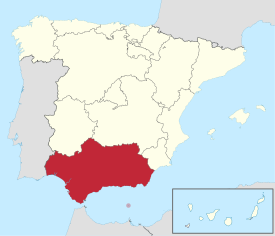
Andalusia in Spain. Source: WikiPedia
The winter weather stays reasonable further north along the coast too, with many motorhome travellers enjoying the region around Benidorm, south of Valencia. Be aware that mountainous areas of Spain can be snow-bound at times during the winter. The Picos de Europa in the north, the Sierra Nevada around Granada and the Pyrenees are all obvious examples.
If you’re looking to head south for the winter and locate yourself in one spot, it’s worth doing some research into medium and long term reduced rates. While the ACSI Camping Card scheme is great for getting costs down for short out-of-season stays, some sites will offer even lower nightly rates for stays of a month or more. Consider booking in advance if you plan to do this, as the best sites are often reported to be full during the winter.
It’s also worth knowing that southern and central Spain can get seriously hot in summer. We once unwittingly stayed too long into spring at a house sit in Andalusia, planning to head across the centre of the country. By the time we set off, temperatures were knocking on 40°C in the cities we wanted to visit. Our pooch wouldn’t cope with that kind of heat, so we found ourselves sticking to the coast and higher altitudes looking for cooler air and shade.
Driving Your Own Motorhome to Spain
To take your motorhome from the UK to Spain you have a basic choice:
- either take a ferry across the Bay of Biscay to Northern Spain,
- or take the Channel Tunnel or a ferry to Northern France, and drive across France to the Pyrenees. On our 2019 tour we drove to the eastern end of the Pyrenees, using the free A75 motorway south of Clermont-Ferrond. We returned from the western end of the Pyrenees mainly using the free N10. Click here for more advice here on driving routes.
This interactive Department for Transport map shows the various ferry routes available: click on any of the ports to see crossing times, which ferry companies service that route and any current disruption to travel. Our personal preference is to drive across France, for these reasons:
- Ju suffers sea sickness, and the Bay of Biscay routes are long old crossings, with a reputation for rough seas in winter.
- We used to travel with our pet dog, and wanted to avoid the cost and inconvenience of a long ferry crossing with him.
- We like France, and enjoy the drive across it.
- We had the time to spend several days (or more likely weeks) driving across France.
Clearly everyone has their own preferences for the drive to Spain, and the map below only shows a few examples of the possible routes. Both general routes across France head for the east and west edges of the Pyrenees, where they dip down towards the sea. The hills are relatively low here, and passable in winter.
Renting a Motorhome in Spain
Motorhome rental companies like mc-rent.es offer motorhomes for rent for pick-up either in Spain, France or another European country, depending on your touring or holiday plans. The rental companies websites usually let you get a quick idea of costs, which tend to vary with motorhome type/size, and season.
For a rough idea of costs, McRent shows the following quotes:
- A 2 week rental of a 2 berth panel van mid January, picked up in Alicante on the Costa Blanca: €1100 (around £1000).
- A 2 week rental of a 4 berth C class coachbuilt in mid June, picked up in Barcelona: €1500 (around £1400).
- A 2 week rental of a 6 berth C class coachbuilt in mid August, picked up in Madrid: £2500 (around £2300).
If you’ve not toured in a motorhome before, have a look at our book, The Motorhome Touring Handbook, for tons of first-hand tips and ideas.
Finding Places to Overnight in Spain
Finding places to overnight in your motorhome in Spain is easy. There’s a good network of aires and campsites – but be aware than many campsites close in winter. Here are some of our favourite resources for finding places to stay:
- Other blogger’s maps (see more info)
- The Camperstop book of aires (see more info)
- The campercontact.com database and app of motorhome aires (see more info)
- The park4night.com database and app listing aires, campsites, free camps and businesses who allow overnight stays (see more info)
- The ACSI CampingCard out-of-season camping discount books (see more info)
- Websites like camping.info are great for finding campsites (see more info)
- All the Aires Spain & Portugal book (see more info)
Note that free (wild) camping in Spain is entirely possible (ourbumble.com has a good database of free camping spots they’ve used), but the legality of it’s not entirely clear to us, and seems to vary with location and time of year, with some places being OK one year but actively policed the next. It also seems to be fine to be parked in some spots with nothing outside the van, but if you use ramps to get level that’s not OK.
If in doubt, ask the local police or tourist information office if it’s OK to stay. We’ve done this in some more remote areas and being made very welcome by the police, while being politely asked to move by the police while free parked (with nothing outside the van) in Benidorm and Mojacar.
Driving in Spain
Other than the busy roads around cities and along the Mediterranean coast, our experience of driving in Spain was very good. The road surfaces are generally in good condition, there are lots of free fast roads and traffic is usually light compared with the UK. That said, there are some challenges to be aware of:
- Speed limits away from motorways can feel very low and more than once we’ve found our speed creeping up on long cross-country routes. Motorhomes under 3500Kg can do 100kph on motorways, while those over 3500Kg are limited to 90kph (from the Caravan Club).
- There are speed cameras in Spain, and they will happily send you a fine through the post. Keep an eye on the actual limits posted on the road rather than relying 100% on your satnav, as limits do change from time to time and for specific sections of road.
- Cities can be interesting to drive through and we try to avoid them where we can. We drove through Valencia, for example, finding ourselves trying to get around huge roundabouts with no lanes marked and requiring more bravery than we’d brought with us!
- In hilly areas crawler lanes are sometimes provided and are great for getting out of the way of faster traffic. Sometimes these continue at the end of the hill, so faster traffic has to get back into the right hand lane. Sometimes you have to merge back across to the left – keep an eye out for signs and arrows.
- You need your lights on for tunnels. There are signs to remind you as you enter and leave each tunnel.
- There are plenty of mountainous areas in Spain where the roads can be fairly steep, narrow, twisting and snow-bound in winter. Our experience (out of winter) has been most roads are passable in a motorhome, but check your map and perhaps look at Google Streetview first if you’re concerned.
For a general overview of driving in Spain, have a read of this website.
Road Rules in Spain
Right – some stuff to know about driving in Spain before you arrive! Here we go…
- You’ll need some mandatory bits and bobs like headlamp deflectors and spare glasses if you wear them – check out the AA PDF of equipment.
- Speed limits and and distance signs are in km, not miles. We switch the units on our satnav to kilometers when we’re waiting for the ferry.
- You can’t drive in open-backed shoes.
- Motorway signs are in blue, like the UK. If a sign says ‘peaje’ on it, it means it’s a toll road so you’ll have to pay to use it. On a map or sign, toll roads have the letter P in the number.
- You can get up to date information on road conditions at this official website.
- You’ll see yellow diamond shaped signs, these mean that you have priority. If you see one with a black line through it, you no longer have priority, traffic from the right does – this is usually on approaches to roundabouts. Sometimes drivers entering the roundabout have priority, if we’re not entirely sure we just take our time and give way to anyone who looks like they aren’t stopping.
- Trams always have priority and if you are driving in the mountains you must use your horn on the approach to blind corners.
Toll Roads in Spain
Spain has a mixture of ‘fast’ roads across the country:
- Free motorways (autovias), typically ‘A’ roads (blue on the map)
- Free national routes which are sometimes dual carriageways (green on the map)
- Paid (toll or peaje) autopistas usually called ‘AP’ roads except around Madrid (red on the map)
- Some toll roads are being made free (the AP-1 is now free, the AP-4 and AP-7 are due to be free from 1 Jan 2020 – see this link)
Spain has a good network of toll-free, fast roads, making it relatively easy to cross at speed without incurring tolls. There are good guides here on how to do just that.
Assuming you do opt for the toll roads, a few tips:
- You can work out the amount you’ll pay using this Spanish website: www.autopistas.com (click here for the Google Translate English version) or you may find www.viamichelin.co.uk easier to use.
- You can pay for them in cash (Euros) or cards at selected booths. We carry cash as not all cards are accepted at the payment booths.
- On toll roads, you generally get a ticket from a machine when you enter the road, and then present it to the toll booth when you leave. The payment amount will then be displayed to you. Some sections of toll road have a fixed fee, so you don’t get a ticket for these roads.
- If you’re in a right hand drive vehicle with no passenger, be prepared to undo your seat belt and cross over to the passenger side to get tickets and pay tolls.
- You can get an auto payment tag allowing you to use the non-stop ‘Telepeaje’, ‘VIA-T’ or ‘T’ lanes, which works in Portugal and France too: more information at this official website.
- All motorhomes pay the same rate, regardless of whether you’re over 3.5 tonnes or not.
Low Emission Zones in Spain
A handful of Spanish cities have ‘clean air’ restrictions over which vehicles can enter their centres, including Barcelona, Valencia and Madrid. You can find up-to-date information on the areas affected, when the LEZs are enforced (some are permanent, some only apply when air pollution is high) and which vehicles are affected at this website: urbanaccessregulations.eu.
If you do plan to head into these zones (personally, we avoid them), you’ll need an ‘environment badge’ sticker for your windscreen. You can obtain these from Spanish post offices, as outlined here.
Petrol, Diesel and LPG in Spain
Diesel, petrol and LPG are widely available in Spain. A few hints and tips for finding and buying these fuels:
- Diesel is called gas-oil in Spain, petrol is gasolina sin plomo, LPG is called GPL or autogas. Diesel pump handles are black or yellow, unleaded are green.
- For a rough idea of fuel prices, have a look at fuel-prices-europe.info.
- LPG is often available at Repsol garages. For a database of LPG locations in Spain and across Europe, go to mylpg.eu. When filling with LPG, you may have to walk over to the cashier and ask them to enable the pump for you. On occasion they have come and filled the van for us.
- Spain uses the Euro LPG adaptor for self-refillable gas bottles.
Motorhome Service Points in Spain
Service points, are areas where you can take on fresh water, and empty your grey water tank and toilet cassette (black water). They’re normally a drive-over drain, with an installation off to one side with two taps: one for taking on fresh water and one for rinsing your cassette out. A few tips for finding and using service points in Spain:
- Unlike in neighbouring France, service points in Spain are almost all ‘artisan’, meaning they’re not commercial machines.
- Spain uses three different tap sizes, so it’s worth carrying ½”, ¾” and 1″ thread Hozelock adapters.
- Almost all campsites have service points. If you pay to stay on a site, the services are included. If you don’t stay, some sites will still let you pop in and use the services for a few Euros.
- There are thousands of service points outside of campsites in Spain. You can find them using apps like campercontact.com and park4night.com. Many of them are free.
- In winter water supplies may be turned off at times when the supply might freeze, so plan to visit a few aires or nip into a campsite from time to time.
- In some areas of the country there are fresh water springs provided away from service points where you can take in water using a carrier.
- Some folks unwittingly use the fresh water tap for rinsing their toilet cassette: we use anti-bacterial wipes to clean the tap before attaching a hose pipe or using a collapsible water carrier.
- We drink Spanish tap water and have had no ill effects.
Using Internet, Phone and Post in Spain
This is how we stay in touch when we’re touring Spain in our motorhome:
- For the Internet we have an unlocked 4G personal WiFi device. This has a Vodafone 30-day 4G SIM card which connects to Spanish networks automatically and proved fast and reliable. We also have a Three Feel at Home PAYG 3G SIM card as a back-up. More info on SIM cards and roaming here.
- Our system (described in detail here) uses a roof-mounted antenna which helps get a better signal, as the metal shell of the van effectively blocks much of the signal.
- For the phone we use SIM cards from 1pmobile.com. We don’t use these for Internet access, although we could turn on mobile data in an emergency, which would cost around £10 per GB
- For mail we only tend to send postcards from Spain, and you can get stamps for these (sellos – pronounced ‘sell-yoss’) from post offices (correos – read more about the Spanish post office). You can also buy stamps from a tabac – recognisable by a maroon and yellow sign.
Supermarkets and Eating Out in Spain
You can eat lots of delicious food in Spanish restaurants for not much money, and the Grey Gappers made the most of it, tasting food across Spain on a year-long motorhome tour of the country. One top tip for eating out is the menú del dia, which is generally an early afternoon three course meal (with 2 or 3 choices), sometimes including wine, for very low prices, typically €12 to €18 a head. More about menú del dia here.
Supermarkets are generally good value too, especially the wine! We tended to use the Alimerka, Lidl, and Super U chains. If paying with your credit card you may need to show your passport as ID (this is the case for any shopping you’re doing). Most places will accept your driving license, but we did have ours refused in one supermarket and we didn’t have our passports with us, fortunately we had just enough cash.
Some larger supermarkets have menú del dia specials at their hot food counters where you can get a three course meal and drink for around €10 per person – there was loads of foods so we split the meal and ate it over several days. Larger stores often have a self-service aisle where you can bag your own dried goods, pasta, rice, cereal etc – but it’s worth double-checking these prices against their discount range as often the discount one is cheaper, but the packet size is large.
Doing Laundry in Spain
Motorhome travellers in Spain don’t enjoy the same network of self-service launderettes found in France, and we often found ourselves heading into campsites just so we could access their washing machines and hang out laundry to dry.
There are launderettes in Spain though, especially useful if you can plan ahead, including some at Repsol garages. Here are some links to chains, which might help you find one on your route, or just search the Internet for lavandería autoservicio:
Touring Spain with a Pet Dog
As long as you have a valid Pet Passport (details of the PETS scheme here), you can travel to Spain with your pet dog, and return into the UK without your pooch having to go into quarantine. We’ve done this many times, and have had no issues. A few hints and tips if you want to tour Spain with your dog or dogs:
- If you don’t have a pet passport, contact your vet early as it can take some weeks/months to get them arranged.
- To return into the UK you’ll need a vet on the continent to administer a worming treatment and then allow between 24 hours and 5 days before re-entering the UK.
- You’ll need to declare your pets when booking the ferry or Channel Tunnel, and pay an additional fee for them.
- Spain doesn’t generally allow pets onto public transport. This can limit your ability to visit cities and other attractions, particularly in summer, unless you have air conditioning in your van to enable you to leave your pet inside.
- Although Spanish supermarkets have wide ranges of pet food available, don’t assume your specific brand will be on the shelves. Either take enough for your trip, research ahead to see if it can be bought in Spain, or plan to transition your dog to locally-available food.
- Leishmaniasis is endemic in Mediterranean Europe, so plan to get either a Scalibor collar or Advantix treatment which protects against sand flies, as well as ticks and fleas.
Note that when the UK leaves the EU, it may be necessary for your pet dog(s) to have a rabies blood test which, depending on how the UK is treated post-Brexit, could delay your departure from the UK by up to four months (check the official government web page here). We’d recommend talking to your vet as early as possible so you’re up-t0-speed on what you need to do.
Are You New to Motorhome Touring?
If you’re new to motorhome touring, then we wrote The Motorhome Touring Handbook just for you. It’s got all the info you need to quickly get up to speed choosing a motorhome and using it to take the biggest adventures of your life!
The Motorhome Touring Handbook is available as a paperback or Kindle eBook. You can read more about the book and buy it from Amazon.co.uk.
More OurTour Motorhome Country Guides
Thanks for reading our guide to Spain! If you’ve found it useful, please consider sharing it using the buttons below? This really helps build the blog’s audience, which in turn helps motivate us to keep it alive and kicking. Cheers, Ju and Jay

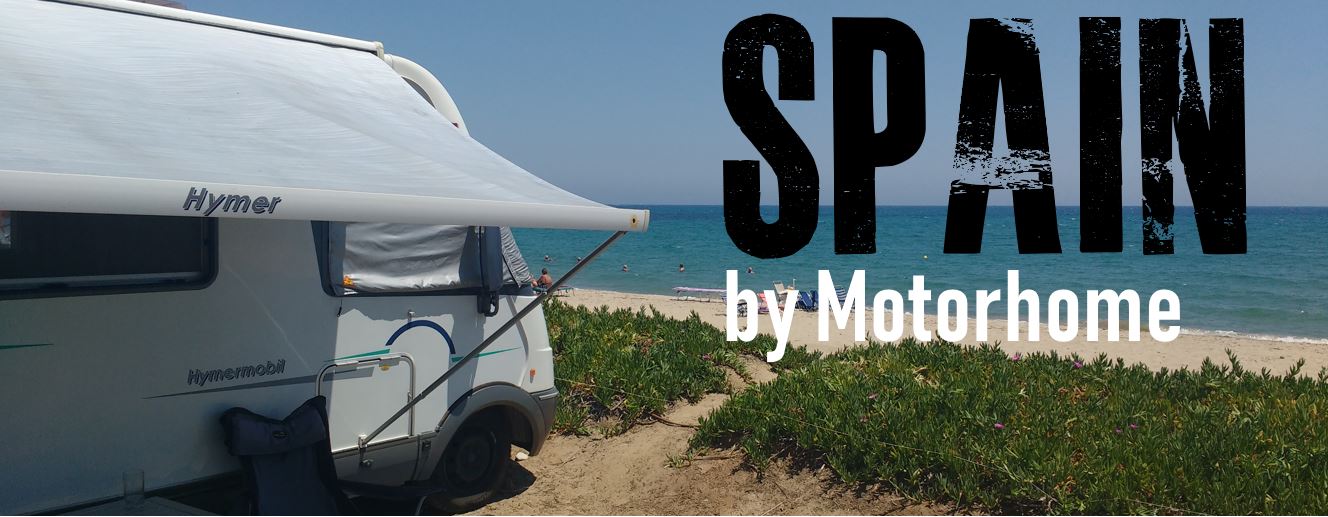
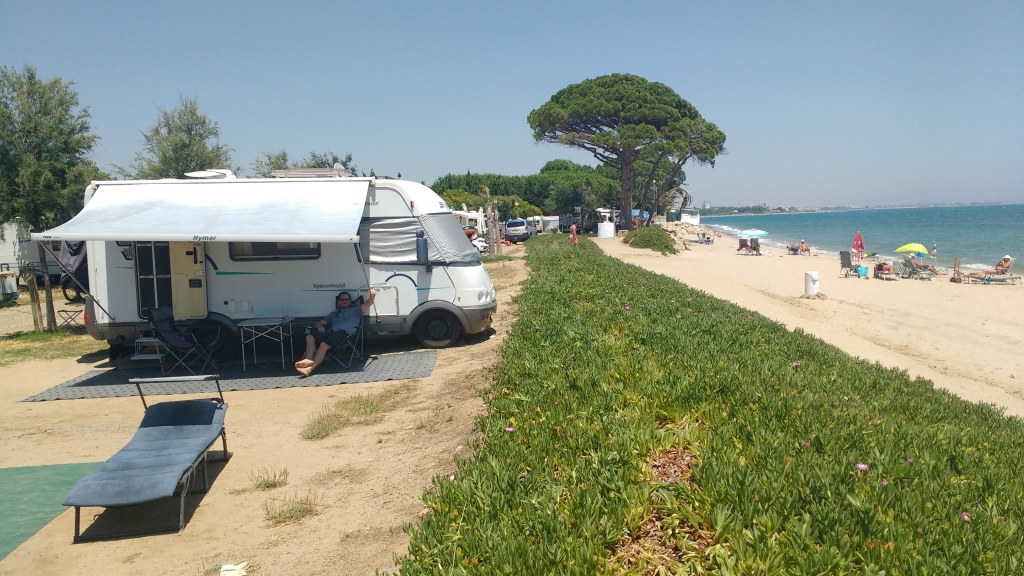
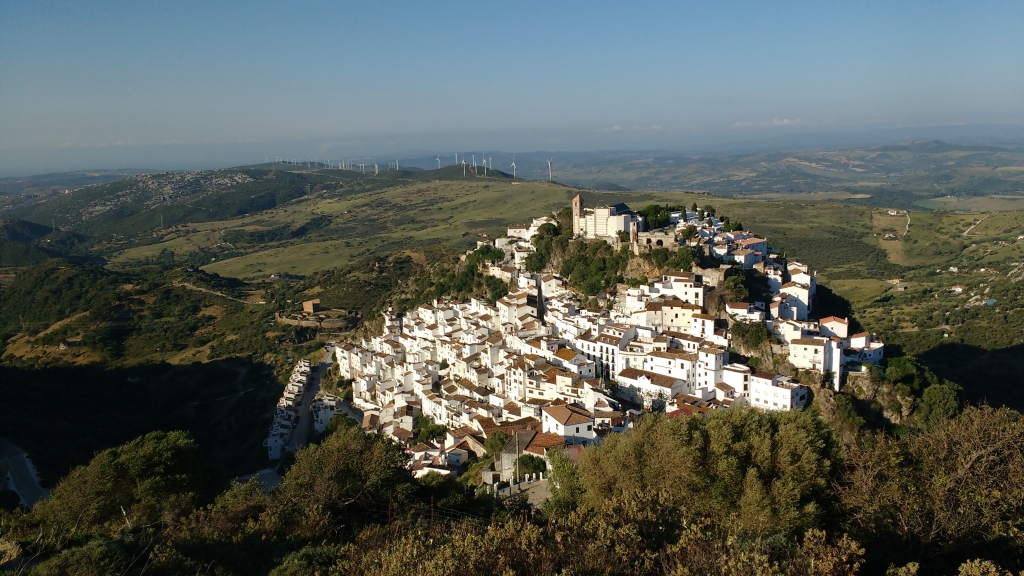
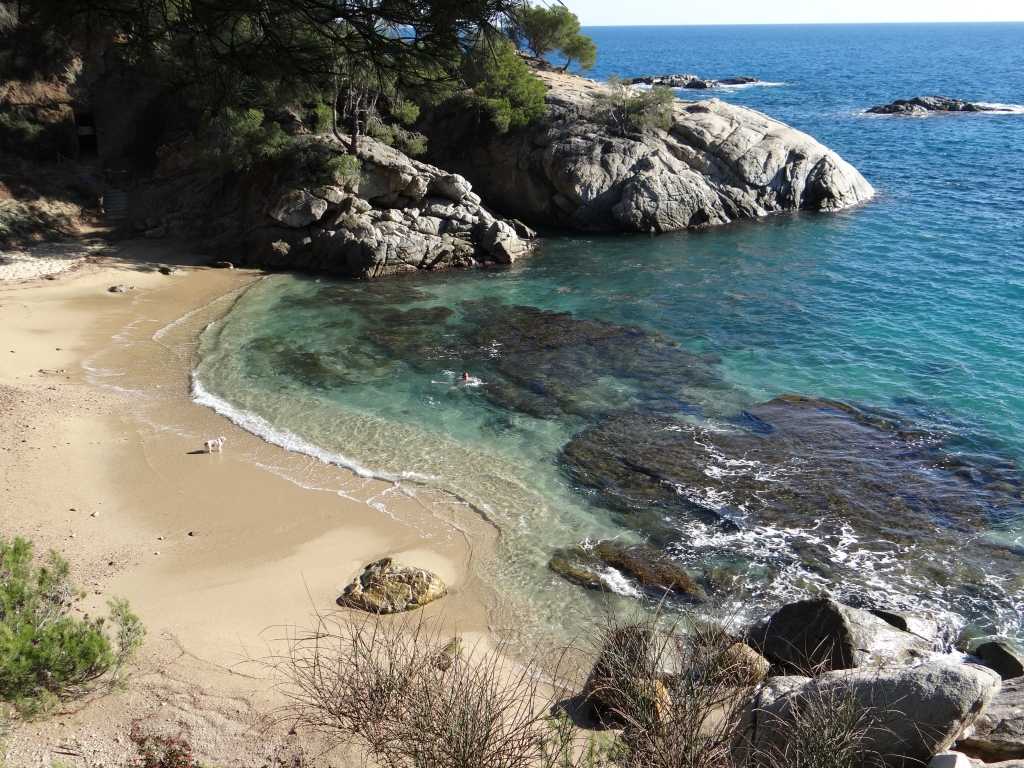
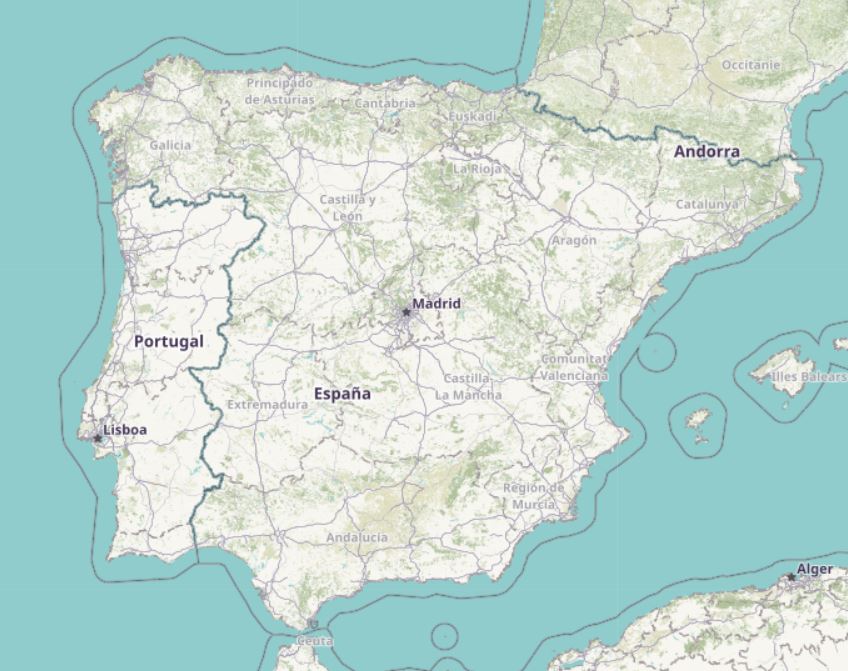
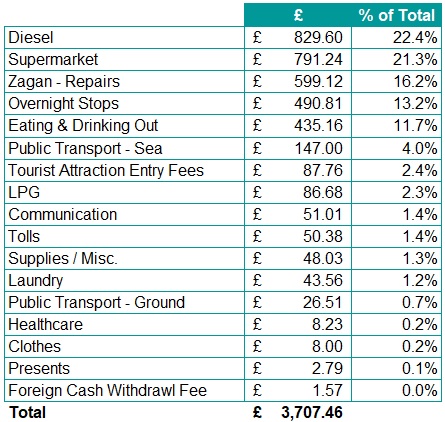
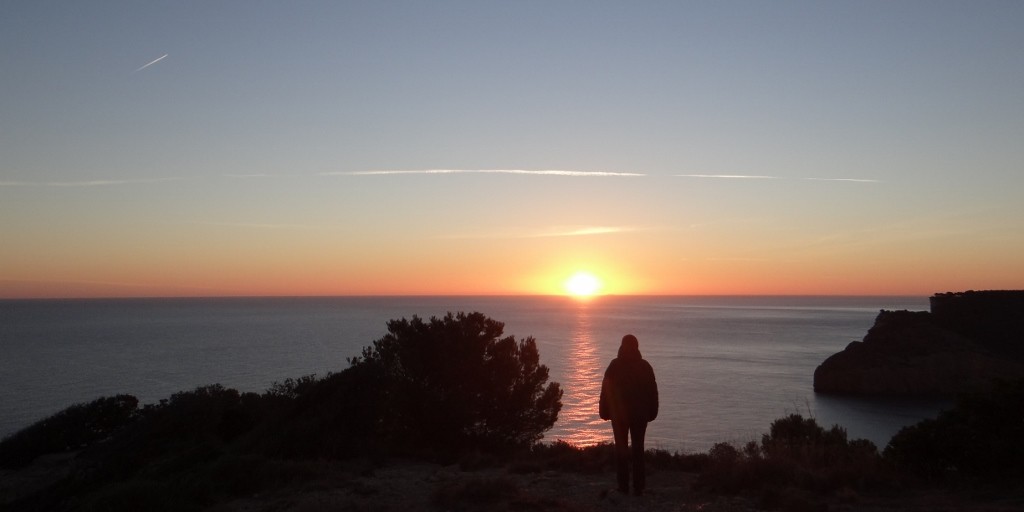
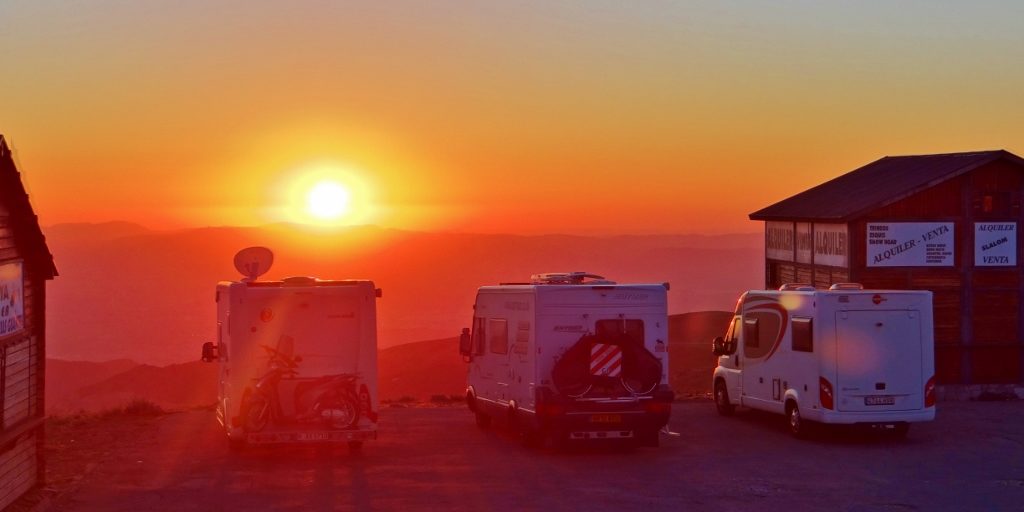
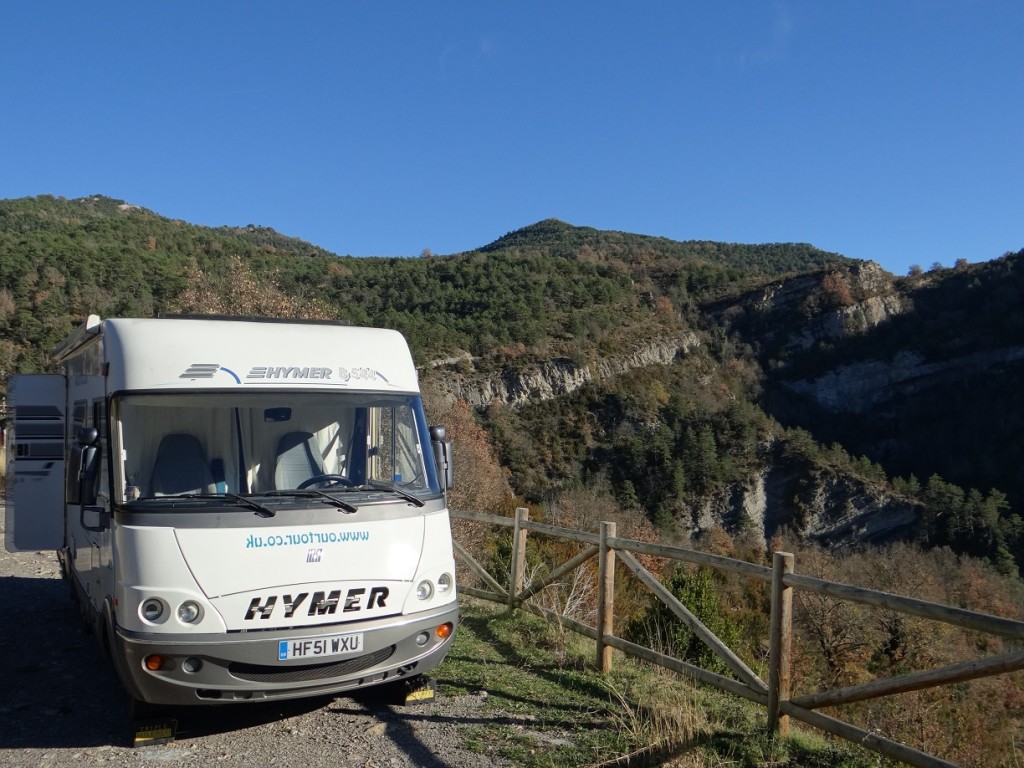
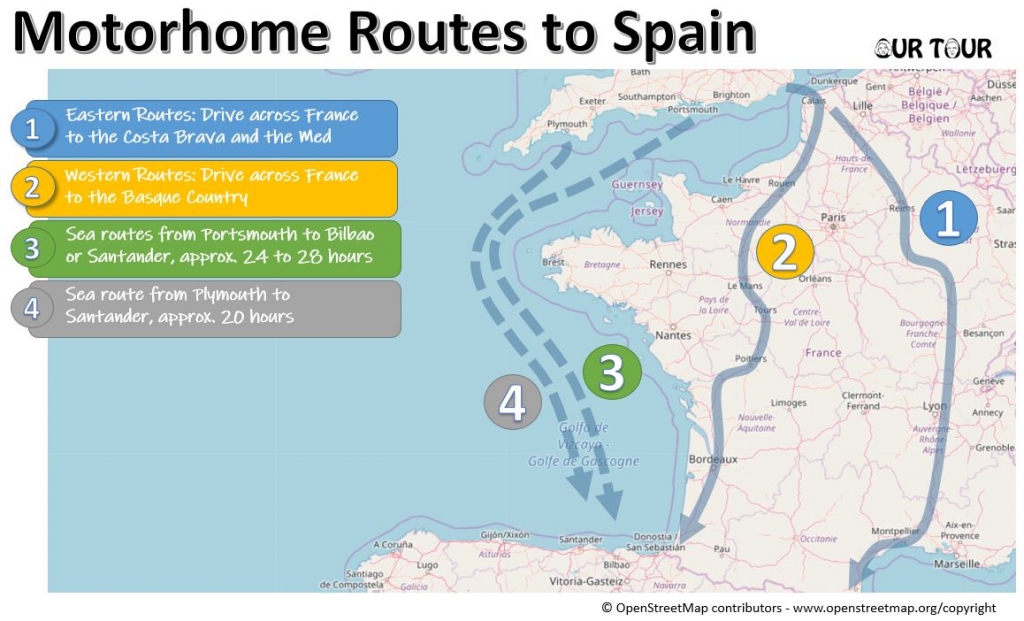
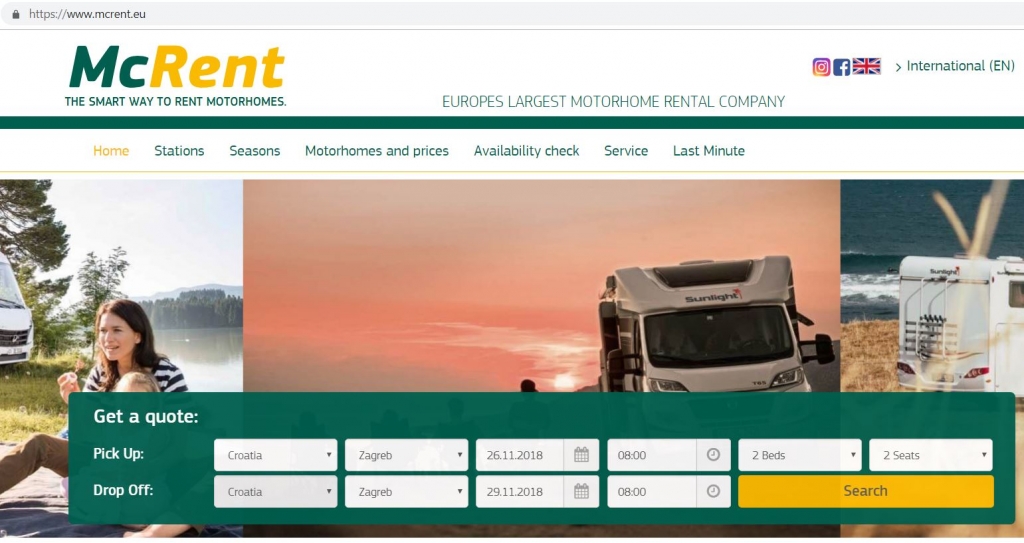
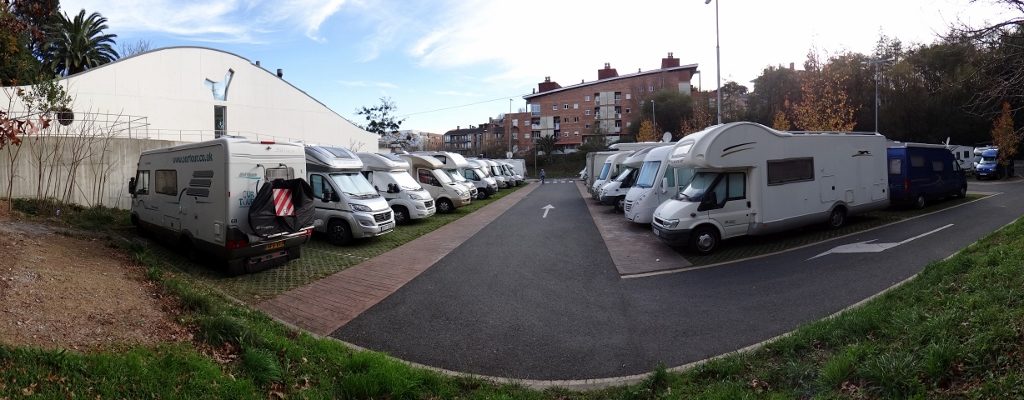
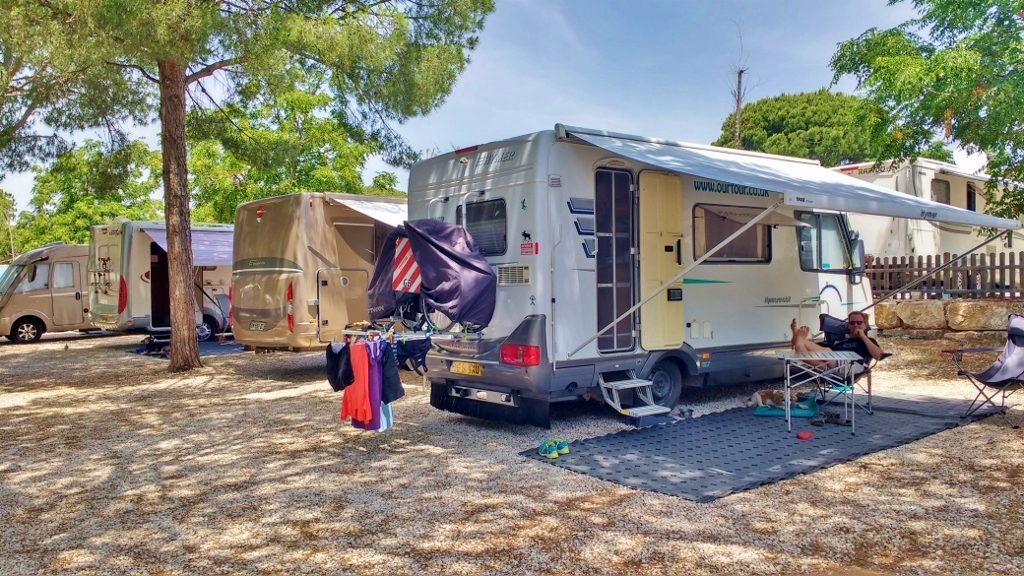
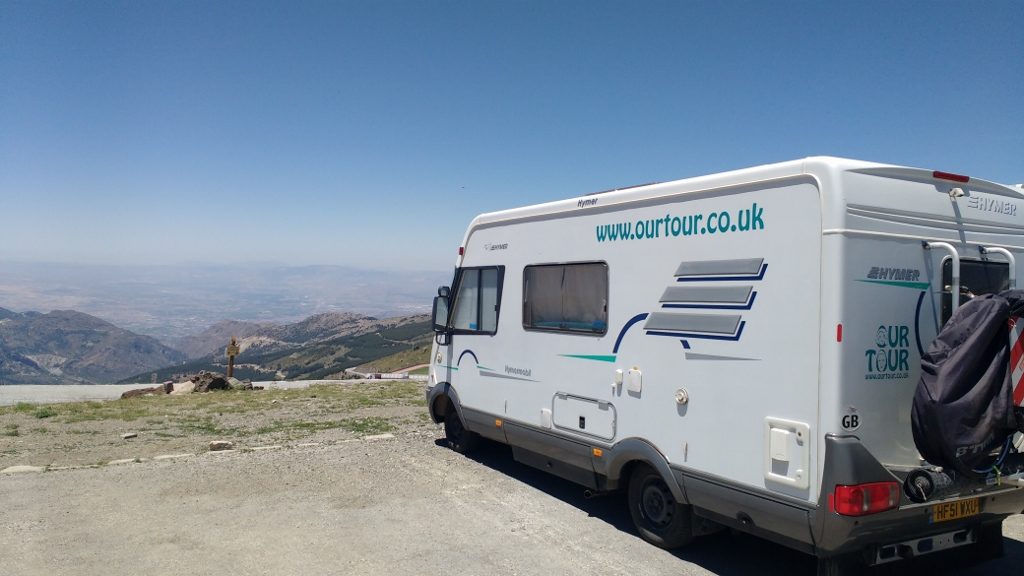
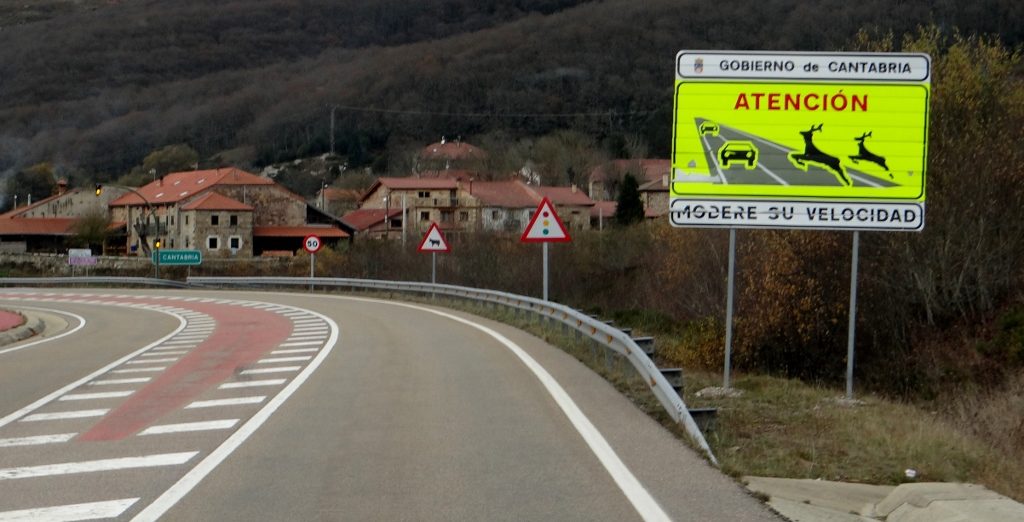
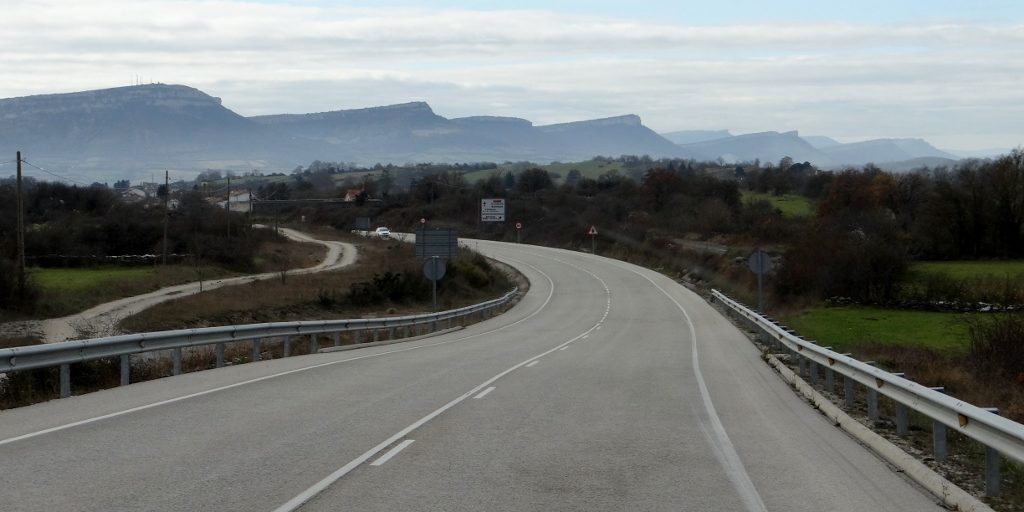
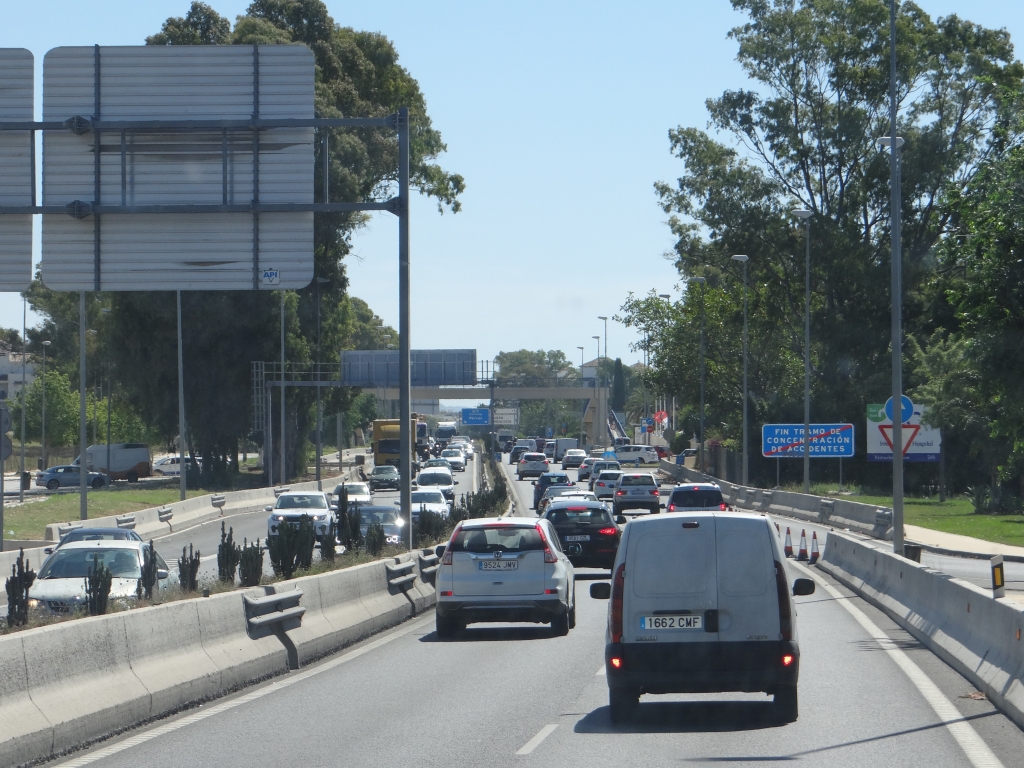
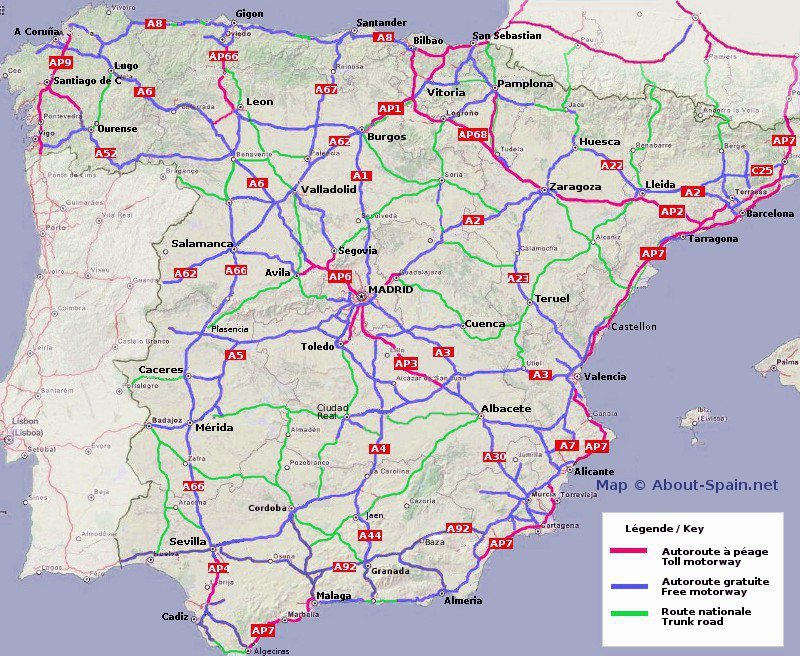
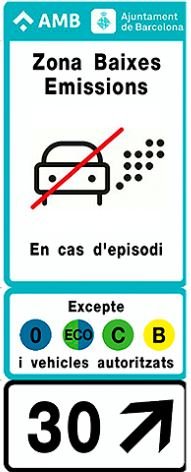
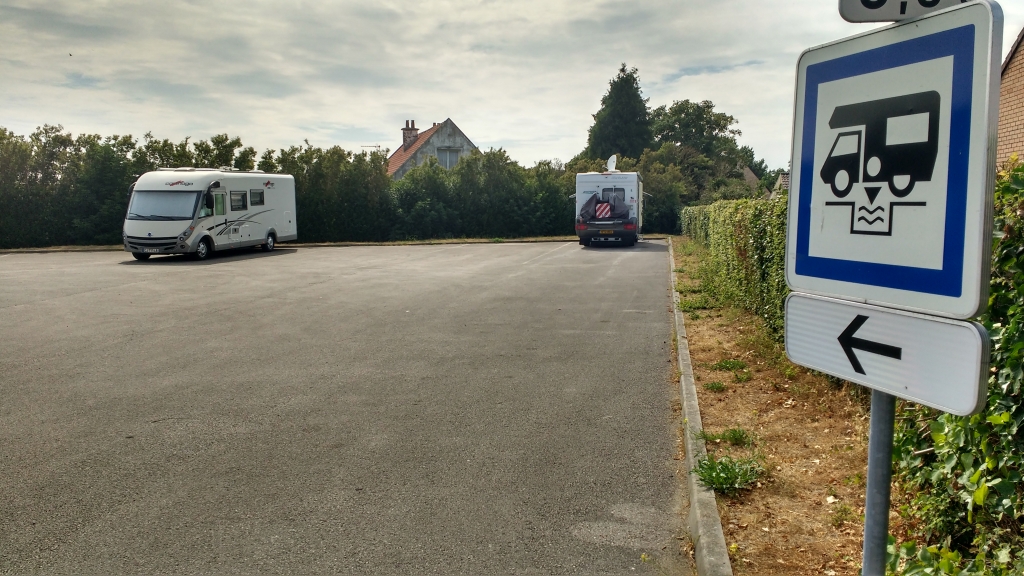

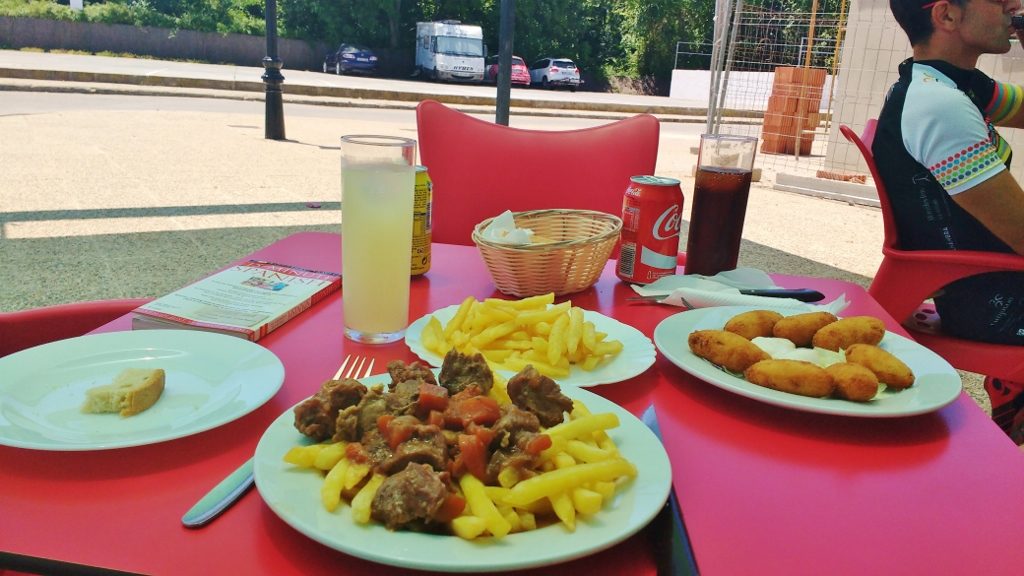
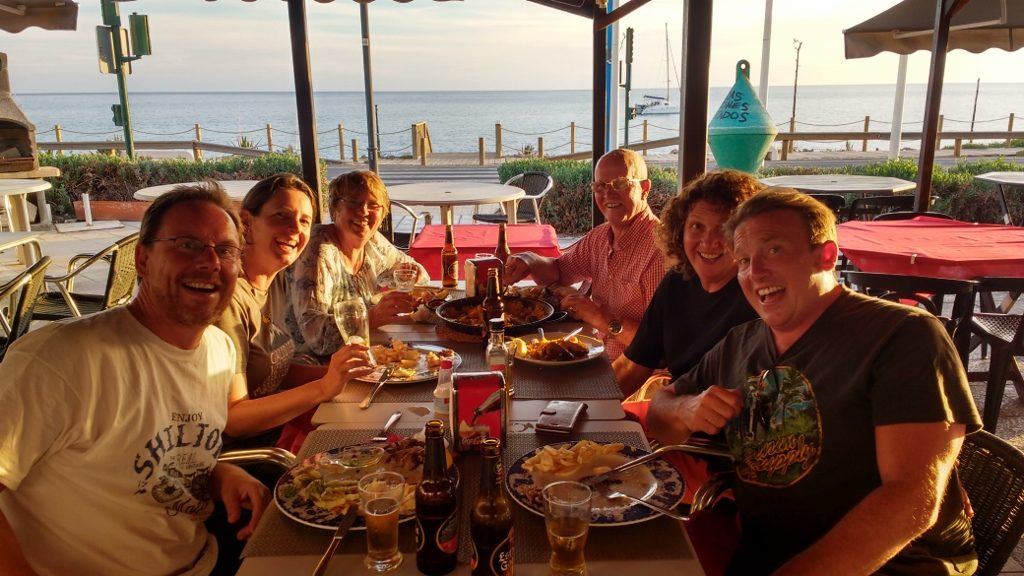
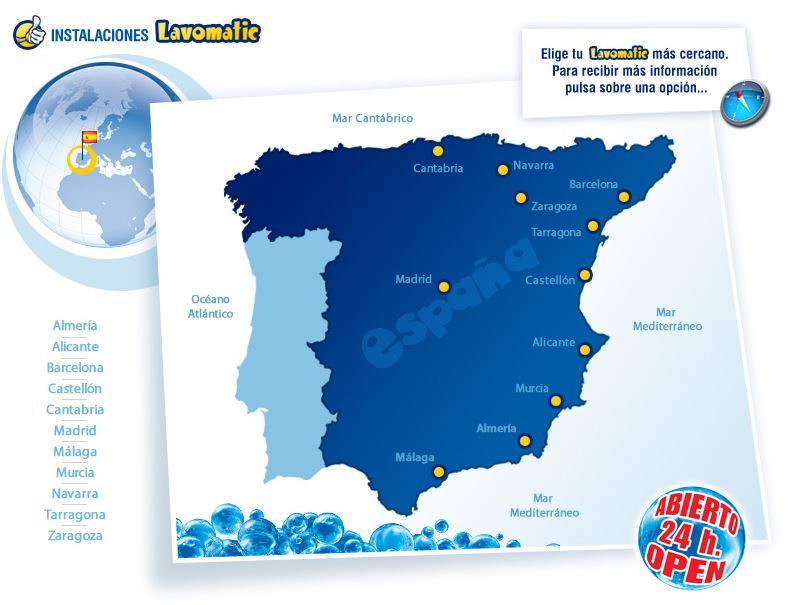
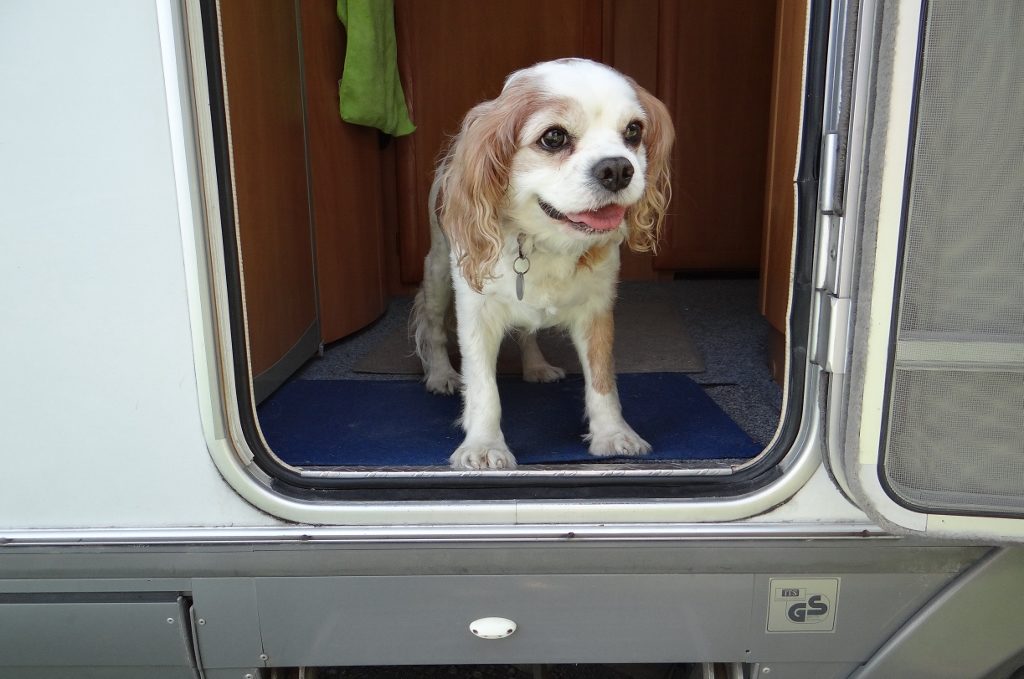
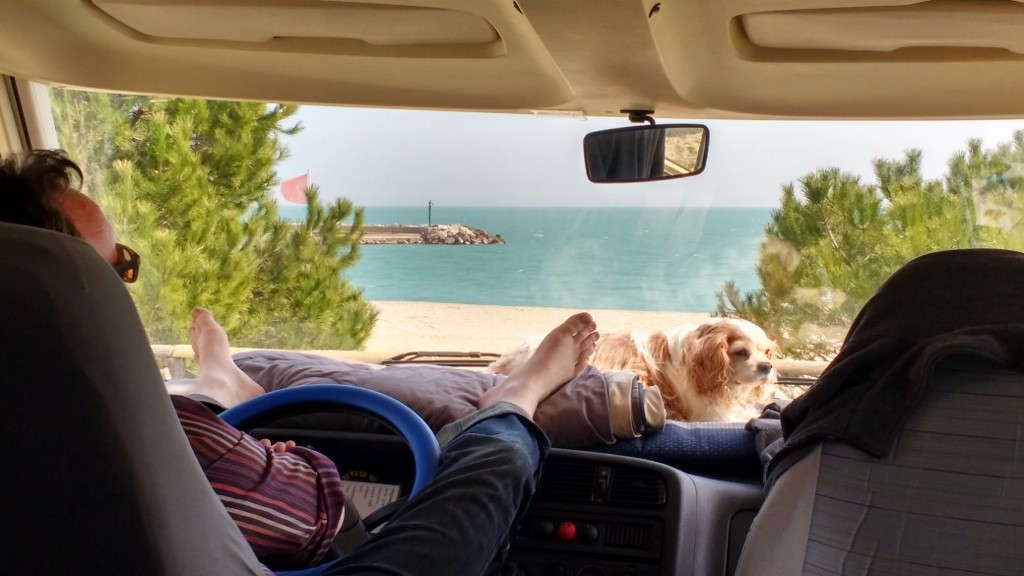
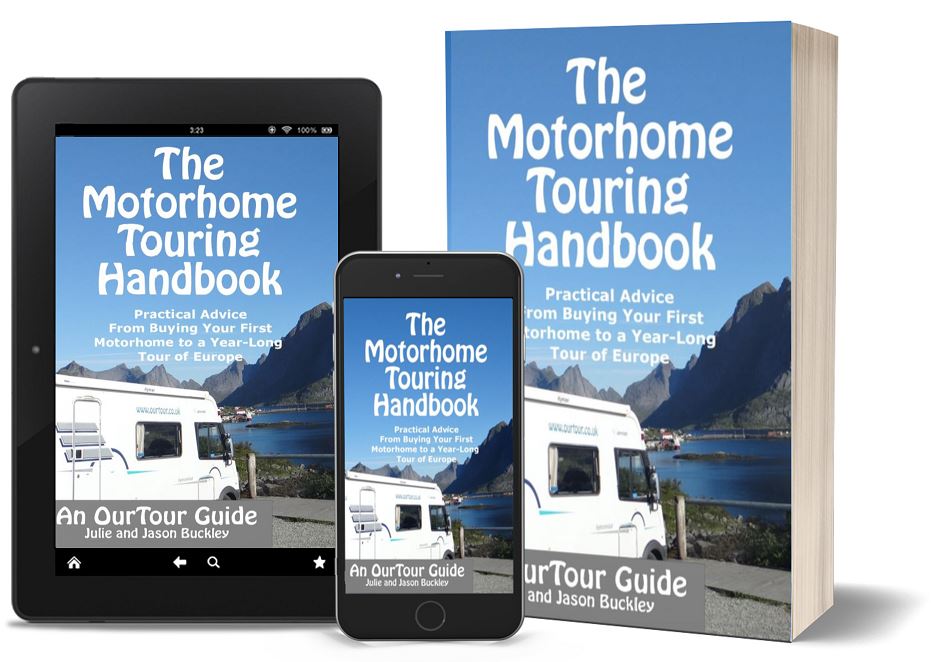

Hi, we are loving the new look blog, it makes navigating the website really easy. We are in discussion on where are next abroad trip is so reading the info by country is fab for us.
Happy travels,
Anne, Andy & Finn
We are a 63 year old couple and seriously considering retiring to southern Spain. We do not really know where to settle as have not visited the country however are attracted by the climate, relative short flight time to and from the UK and popularity with English speaking like minded people. We are hoping to commence our journey in January 2021, subject to the completion of the sale of our UK home.
We want to settle somewhere which is not overly touristy has a decent expat or English speaking community where we would wish to ingratiate ourselves and become part of that community. We do not speak Spanish however would be keen to learn.
Our thoughts were to either:-
sail/drive over in our car and spend 6 months visiting many of the locations that we have seen on the numerous television shows about settling abroad, staying in accommodation a few weeks at each location so as to try to get a feel for the place,
alternatively, travel over, buy/rent a motorhome and do likewise travelling to the various destinations which would give us more freedom but possibly more stress.
Any advice would be really appreciated please?
Hi Robert. To be honest it isn’t something we’ve done personally (looked for somewhere to live in Spain) so I’m not sure how relevant our experience will be to you. I’ll offer what thoughts I can though of course.
I guess you’re aware of the fact the UK has left the EU, so as of Jan 2021 the time we can spend in Spain will be limited unless we obtain residence or a long-stay visa.
We’ve loved travelling Spain in our motorhome, and I think it’s given us a good (superficial) view of the various regions. When we did spend a few weeks at a house sit we saw a different side to life in the town though, and we’ve found places ‘feel’ a lot different in summer when tourists increase and the heat can be oppressive.
Personally I think unless I planned to keep a motorhome after settling down, I wouldn’t buy one. I’d use a car and Airbnb (or similar) to stay in each area I’d researched beforehand to get a better feel for living in them. I’d talk to the Airbnb owner to ask them what life is like there all year round.
Some towns aren’t motorhome-friendly, for example, and with a car you could spend time visiting around the local area without having to drive a MoHo, which isn’t always easy on some rural roads.
Good luck, have fun! Jason
absolutely brilliant information enjoyed reading your experiences and travels the only thing missing from your list is health insurance / health issues what happens if your taken ill on your travels what health insurance covers you and any trips to a hospital as nobody seems to mention any of this in there blogs other than that keep up the good work
Happy motor homing regards Dave